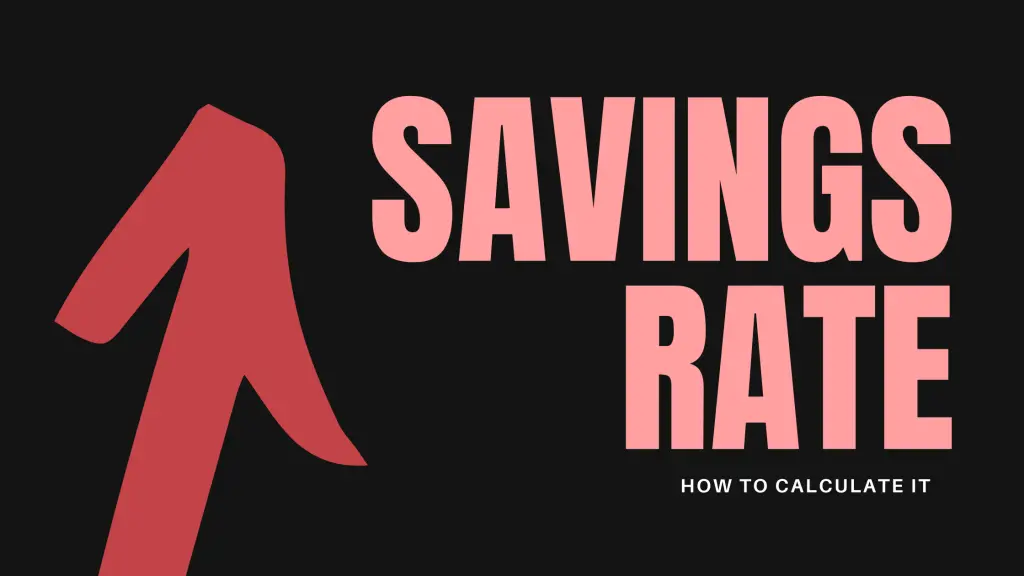At its core, your savings rate is a fairly simple mathematical expression which is your personal profit divided by your income. In this article we’ll take it deeper and walk you through exactly how to calculate your savings rate so that you can be confident you’ve calculated it correctly.
What is a savings rate?
In the context of personal finance, your savings rate is the proportion of your income which you save.
In business parlour, this is often referred to as the profit margin i.e the proportion of your revenue (income) that is profit.
Back to personal finance, remember that your personal profit is calculated as below:
Personal Profit = Income – Expenses
To work out your savings rate, simply divide your personal profit figure by your income figure (then multiply the result by 100 to get to the percentage.
Savings Rate = ( Personal Profit / Income ) x 100
As an example…
Jeremy earns £2,000 after tax, and spends £1,600 per month on all of his expenses. He therefore has a personal profit of £400 per month (2,000 – 1,600).
His savings rate is 20% (400 / 2,000 * 100).
If he reduced his expenses from £1,600 per month down to £1,400 per month, his personal profit would increase by £200 to £600 per month. This would increase his savings rate to 30%.
Why does a savings rate matter?
It is such an important metric to monitor, as generally (and very bluntly) speaking, a higher savings rate gives you more flexibility and freedom to invest in your personal finance goals.
It is quite literally the engine helping you to achieve your personal finance goals
Without a positive savings rate (i.e without making a personal profit), you are never going to be able to work towards your financial goals.
Making a personal profit (i.e having a positive savings rate) is the foundation of almost everything in your personal financial situation.
I can’t overemphasise this enough, it needs to be positive.
If it isn’t, then you need to put in place the changes in order for it to be positive. Analyse your previous 6-12 months worth of spending, build a budget that allows you to turn a personal profit, and then put in place the actions necessary to hit your budget each month.
Once it is positive, i.e you’re making a personal profit, then you can start to funnel these savings towards your goals. Be it paying down your debt, building up an emergency fund, building up a house deposit, saving for a wedding etc etc.
As an example, I built up my savings rate to 40-50%, which meant I was able to pay off £2k of consumer debt and save an additional £9k in less than 12 months.
It is a shock stopper
Think of a higher savings rate as a buffer, which absorbs most external shocks.
In the example of Jeremy above, as he has a savings rate of 20%, it means either his income can take a 20% hit or his expenses can unexpectedly rise by 25%, and he will be able to absorb that without any lifestyle changes.
This is super handy, as life always throws little surprises your way (especially when you’re least expecting it). So having a built in buffer in your monthly financial situation will only help set you in good stead.
Simplicity
If there is one metric that you look at on a monthly basis, this is a good one to keep an eye on.
Generally speaking, a higher savings rate is better, and therefore keeping track of this metric over time can act as a really powerful motivator. Due to its simplicity and high take up rate with people in the personal finance world, you’ll find it very easy to compare your progress with others.
It also provides clear actions, in that you know the two components that make it up; income and expenses.
These are the two levers available to you to pull to improve your savings rate, and I like that it makes that very clear that they both are important as sometimes it is easy to be too blinkered just looking at implementing frugality tips to reduce your expenses, meaning you ignore the other huge lever you can pull to improve your savings rate (income!).
This tends to be because expenses are almost exclusively under your control, and can be reduced very quickly. The downside is that this half of the equation has a hard bottom, as you’ve still got to have some expenses to live!
The other side, income, has no such limit (theoretically!), but is harder to increase quickly (but you definitely can!).
As an example, by increasing my income by taking on a bit of freelancing on the side of my day job, I was able to increase my savings rate from ~30% to ~50%! No change in lifestyle needed.
How do I calculate my savings rate?
You’ll need details of your income, and details of your expenses. Try to use actual after-tax cash receipts for your income rather than pre-tax numbers.
If you get paid monthly from your employer, this is super easy as you should just take the figure that lands into your bank account each month.
If you get paid your income pre-tax, then do an estimate for your post-tax amount – you can use a tax calculator to help you estimate your post-tax amount.
I would recommend not only collating this information for the most recent month, but also go back the last 12 months (further if you have the data!), as this way you can see how it is trending over time and will help iron out any seasonality to your spending and/or income.
It is super important that you collect ALL expenses and ALL income, not just cherrypicking accounts. Make sure to include all money you spend on credit cards etc too.
Set up a simple spreadsheet with a row for Income and a row for Expenses, with the different months along the top in separate columns.
Simply fill out each, and then calculate the savings rate.
This is in two steps;
- In a row beneath your Income and Expenses in a new cell, title it “Personal Profit” and calculate Income minus Expenses for each month
- Then in the row beneath, title it “Savings Rate” and calculate it as personal profit divided by income, multiplied by 100 to get to a percentage (or simply press the % option in Excel / Google Sheets which will turn the decimal into a percentage for you).
You should now be able to see the progress of your savings rate over time and to spot whether it is increasing or decreasing.
What is a good savings rate?
Good question! Generally speaking, a higher savings rate is better in almost all situations. I’ve answered this question in more detail in an article answering; “what is a good percentage to save from your paycheck?“.
The only situation in which a higher savings rate is not necessarily a good idea is if the trade-off of increasing your savings rate becomes too big for it to be worth it (if you’re only pulling the level of lower expenses).
Say for example you are already at a 40% savings rate, but to get to a 50% savings rate without earning more money you would need to significantly scale back your discretionary spending which meant that you can’t enjoy some of the things you tend to do i.e going out with friends or pursuing the hobby that keeps you sane, then I would argue you’re better off staying at 40%, enjoying your socialising and hobby and grow towards your goal at a slower pace.
Of course the happy solution is to find a way to increase your income, keeping your expenses flat, and that way you get to maintain the same lifestyle while increasing your savings rate.
Back to the question – what is a good savings rate?
This will very much depend on your goals and the time-frame that you want to hit that goal.
If you are aiming to pay off a large chunk of debt quickly, or want to aim to retire in the next 5 years, then you’ll need to aim for as high a savings rate as you possible can. We’re talking 40%+.
However, if you are happy taking a slower approach to your goals, you can afford for your savings rate to be lower.
However, I would recommend to push the savings rate as high as you can (minimum 30%), due to the myriad of benefits discussed above such as acting as a buffer and providing the engine for your personal finance goals.
How do I increase my savings rate?
By;
- increasing your income
- reducing your expenses
Ideally both!
Want to know how to reduce your expenses? Read my budgeting guide as well as learning about painful vs pain-free savings.
Alternatively, try hacking your mind by putting a small percentage of your after-tax income into a completely separate savings account (ideally one where you don’t have much access to so you can’t be tempted easily), and slowly increase this percentage each month.
If you start with 1% and increase it by 1% point each month, you’ll be at 12% after 1 year! You would no doubt be adjusting your lifestyle by default by spending less each month as the percentages get bigger, but the increment is so small that you would be unlikely to notice!
Better yet, automate the process using a standing order or using a programme like IFTTT (if this then that) if your bank supports it to automatically move the money to a savings account. Out of sight, out of mind!
How has your savings rate been trending over time? I’d love to hear how you track your savings rate and if you find it a useful metric to follow. Let me know in the comments box below.
What Is A Good Amount Of Savings UK?
Generally in life, more tends to be better. But is that true for savings? Whilst…
“Why Should I Track My Expenses?” – We’ve got 7 reasons why!
Tracking your expenses isn’t all about firing up a spreadsheet and restricting your spending. Having…
How To Cancel Graze Subscription UK
Bored of your Graze boxes or want to try a competitor’s version? We get you….
How To Cancel Hellofresh Subscription UK
Bored of the meal kits or want to try a competitor? We get you. We’ve…
How To Cancel Les Mills On Demand UK
Bored of your subscription or wanting to move to another provider? We get you. We’ve…
How To Cancel Laithwaites Wine Plan UK
Bored of the service or wanting to move to a different wine subscription club? We…









Pingback: How to create a budget in excel that'll even impress your accountant!
Pingback: How to set up a budget in Google Sheets | The Mindful Money Project
Pingback: Is Saving £1000 a Month Good? | The Mindful Money Project
Pingback: How To Stick To Your Budget When Nothing Works